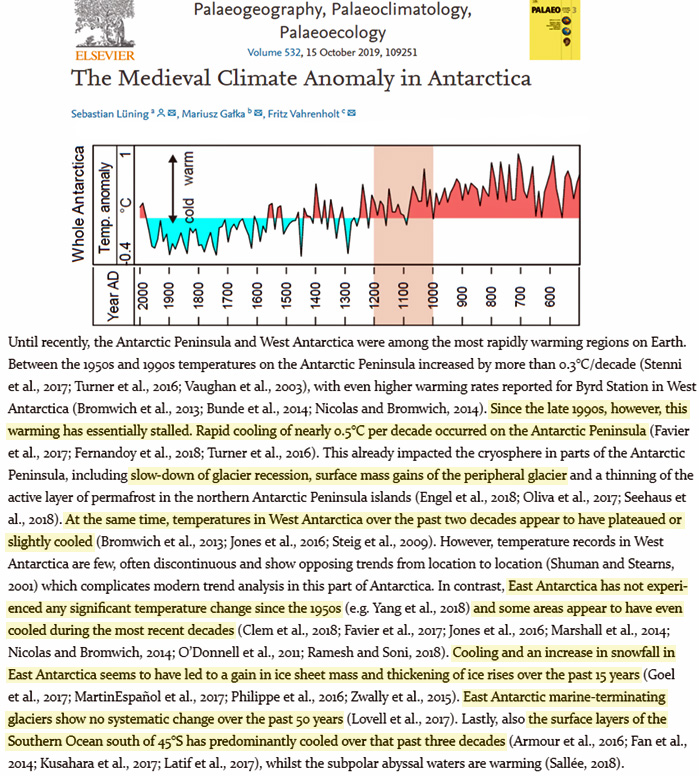"Natural variability rules in Antarctica. Scientists identify clouds, wind, and localized solar heating – not CO2 – as the factors driving ice melt. Rising CO2 leads to Antarctic cooling.

Antarctica rapidly cooling in recent decades
In a review of the scientific literature, Lüning et al. 2019 report Antarctica as a whole has undergone a cooling trend in recent decades.
The Antarctic Peninsula has cooled at a rate of -0.5°C per decade since the late 1990s.
West Antarctica as a whole has “slightly cooled” (or the warming has “plateaued”) over the past two decades.
East Antarctica “has not experienced any significant temperature change since the 1950s” with ice sheet mass gains and cooling during the past 15 years.
Rising CO2 leads to Antarctic cooling
Antarctica contains about 90% of the world’s ice.
Because the continent averages -28.2°C in summer and -60°C in winter, inducing even partial retreat for an ice sheet that averages 2.3 kilometers in height would require a substantial amount of heat energy.
This effectively rules out a human influence.
According to scientists, raising CO2 concentrations does not even lead to warming in Antarctica.
Actually, scientists find Antarctica cools in response to rising CO2 concentrations, which means we humans may be contributing more to ice mass gains than to losses.
Natural variability – clouds, wind, localized solar heating – drive Antarctic ice melt
The surface melting of portions of the West Antarctic Ice Sheet (WAIS) has received quite a bit of attention in media circles, often accompanied by scary warnings of ice sheet collapse and catastrophic sea level rise.
For example, Dr. James Hansen – admitting his doomsday predictions are tendentiously designed to be “persuasive” – has claimed sea levels will rise by 10 feet by 2065 mostly due to Antarctic ice sheet melt.
These harrowing warnings often seem to arise in response to observations of glacier calving events – large glaciers fissuring and breaking off from the ice sheet.
But glaciologists know that calving events are indicative of ice sheet thickening, not thinning. Glaciers calve when the ice accumulation has become so heavy and thick that the base of the ice sheet can no longer bear the load.
Yes, portions of Antarctica are undergoing ice melt. But ice sheet recession and advancement are both natural. And modern ice melt is well within the range of what occurs naturally for Antarctica.
Indeed, as Jones et al. (2016) conclude, natural variability “overwhelms” any forced response in satellite era trend observations.
In two new papers, scientists identify the natural mechanisms driving the recession of some of West Antarctica’s glaciers in recent decades.
Scott et al. (2019) conclude surface melt is driven by wind currents and downwelling longwave radiation from clouds.
Stewart et al. (2019) find localized solar heating of surface water can explain melting in small portions of the Ross Ice Shelf.
Considering the total Antarctic meltwater contribution to sea level rise may only amount to 0.34 of a centimeter since 1958 (Frederikse et al., 2018), it is quite reasonable to conclude that nothing unusual, unprecedented, or concerning is occurring in Antarctica that could be said to fall outside the range of natural variability."
Monday, July 15, 2019
Scientists Find Antarctica Is Rapidly Cooling And Any Ice Sheet Melt Is Not Due To CO2, But Natural
From No Trick Zone.
Subscribe to:
Post Comments (Atom)
No comments:
Post a Comment
Note: Only a member of this blog may post a comment.